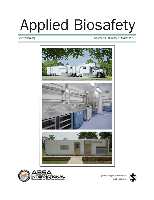
Applied Biosafety
Scope & Guideline
Ensuring safety in the age of biotechnology.
Introduction
Aims and Scopes
- Biosafety and Biosecurity Practices:
Research aimed at improving protocols and practices for managing biological materials safely in laboratories, including risk assessments, training programs, and regulatory compliance. - Decontamination and Sterilization Techniques:
Exploration of methods for effectively decontaminating laboratory environments and equipment, including the development and validation of new sterilization technologies. - Emerging Pathogens and Biocontainment:
Studies addressing the challenges posed by emerging infectious diseases and the necessary biocontainment strategies to mitigate risks associated with high-consequence pathogens. - Synthetic Biology and Biosecurity:
Research focused on the implications of synthetic biology advancements, including risk assessments and regulatory frameworks for synthetic nucleic acids and genetically modified organisms. - Education and Training in Biosafety:
Development of educational frameworks and training programs to enhance the competencies of biosafety professionals and researchers in handling biological agents.
Trending and Emerging
- Synthetic Genomics and Biosecurity:
A notable increase in research surrounding the biosecurity implications of synthetic genomics reflects growing concerns over the risks associated with genetic engineering and biomanufacturing. - COVID-19 and Pandemic Preparedness:
The ongoing impact of the COVID-19 pandemic has led to a surge in publications addressing biosafety practices, risk assessments, and lessons learned from the pandemic to enhance future preparedness. - Artificial Intelligence in Biosafety:
Emerging discussions around the role of artificial intelligence in biosafety practices indicate a trend towards integrating advanced technologies to improve risk management and laboratory safety. - Global Biosafety Standards and Regulations:
Increased focus on harmonizing biosafety standards and practices across countries, reflecting the global nature of biological threats and the need for cohesive regulatory frameworks. - Innovative Decontamination Technologies:
Research into novel decontamination methods, including the use of advanced chemical agents and physical sterilization techniques, is on the rise, driven by the need for improved safety measures in laboratories.
Declining or Waning
- Traditional Laboratory Safety Protocols:
Research related to conventional biosafety measures has decreased, possibly due to the rapid evolution of technology and methodologies that require more advanced and innovative approaches. - General Microbial Risk Assessments:
The focus on broad microbial risk assessments may be declining as the journal shifts towards more specific and emerging pathogens, reflecting a need for targeted studies in response to recent global health challenges. - Basic Biosafety Training:
Papers centered on introductory biosafety training have become less frequent, indicating a shift towards more specialized training programs that address advanced topics and current challenges in the field.
Similar Journals

BIOTECHNOLOGY LAW REPORT
Exploring the Legal Landscape of BiotechnologyBIOTECHNOLOGY LAW REPORT, published by MARY ANN LIEBERT, INC, serves as a pivotal platform for professionals and researchers engaged in the intersection of biotechnology and law. This esteemed journal, with ISSN 0730-031X and E-ISSN 1557-8704, provides critical insights into legal issues and regulatory developments surrounding biotechnological innovations. Covering a diverse range of topics from intellectual property rights to environmental law, the journal aims to foster informed dialogue and policy advancements in a rapidly evolving field. Although it currently stands in the Q4 category for both Biotechnology and Management, Monitoring, Policy and Law, the relevance of its content persists alongside its significant contributions from industry experts and academics. Published in the United States, the journal is committed to offering comprehensive coverage of pertinent themes, despite limited open access options. As it converges its publication years towards the future, BIOTECHNOLOGY LAW REPORT remains crucial for those navigating the complexities of biotechnology legislation and its global implications.
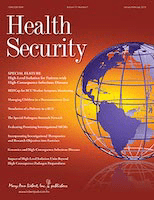
Health Security
Navigating the complexities of global health security.Health Security is a premier academic journal published by MARY ANN LIEBERT, INC, specializing in critical areas of public health, emergency medicine, and health policy. Since its inception in 2015, the journal has established itself as a vital resource for researchers, policymakers, and health professionals alike, boasting exceptional impact factors across multiple relevant categories, including Q1 in Emergency Medicine and Q1 in Safety Research. This esteemed publication not only contributes to the academic discourse surrounding health and safety but also offers open access options to maximize the dissemination of knowledge and innovative research. Health Security is dedicated to exploring the intersection of health, security, and safety, providing readers with timely and robust analysis that is particularly pertinent in today’s complex and evolving global health landscape. For those engaged in grassroots policy development or frontline emergency response, the journal stands as an indispensable tool for fostering understanding and facilitating informed action in an ever-changing environment.
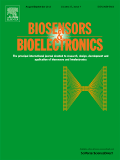
BIOSENSORS & BIOELECTRONICS
Shaping Tomorrow's Technologies Through Rigorous ResearchBIOSENSORS & BIOELECTRONICS, published by Elsevier Advanced Technology, is at the forefront of research and innovation in the realms of biomedical engineering, biophysics, and biotechnology. Established in 1990, this esteemed journal has established itself as a premier platform, receiving a prestigious Q1 ranking across multiple categories, including Electrochemistry and Nanoscience, reflecting its critical impact on advancing scientific knowledge and technology. With an impressive range of topics, including the latest trends in biosensor development and bioelectronic application, it serves as an invaluable resource for researchers, professionals, and students alike, facilitating collaborative dialogue and innovative solutions. Though primarily subscription-based, the journal is accessible from its UK headquarters in Oxford, promising rigorous peer-reviewed articles that inform future trends and applications in this dynamic field.
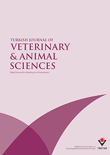
TURKISH JOURNAL OF VETERINARY & ANIMAL SCIENCES
Advancing Veterinary Science for a Healthier Tomorrow.TURKISH JOURNAL OF VETERINARY & ANIMAL SCIENCES is a distinguished peer-reviewed journal dedicated to advancing knowledge in the field of veterinary sciences and animal health. Published by the Tubitak Scientific & Technological Research Council Turkey, this journal provides a platform for high-quality research, fostering scientific inquiry that spans various aspects of veterinary medicine, animal biology, and animal husbandry. With an impact factor that reflects its growing influence within the Q3 category of Veterinary (miscellaneous) according to the 2023 rankings, it is strategically positioned in the academic landscape, ranked #112 out of 194 in the broader veterinary field. The journal is committed to open access publications, ensuring that research is accessible to a global audience, facilitating collaboration and knowledge sharing among researchers, professionals, and students. By covering a broad spectrum of topics from clinical research to veterinary policy, the TURKISH JOURNAL OF VETERINARY & ANIMAL SCIENCES plays a crucial role in enhancing the understanding and welfare of animal species, thereby contributing significantly to both scientific advancement and practical applications in veterinary practice.
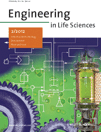
ENGINEERING IN LIFE SCIENCES
Innovating at the Crossroads of Bioengineering and Environmental ScienceENGINEERING IN LIFE SCIENCES, published by Wiley, is a pivotal journal for professionals, researchers, and students dedicated to advancing the interdisciplinary fields of bioengineering, biotechnology, and environmental engineering. With an ISSN of 1618-0240 and an E-ISSN of 1618-2863, this journal has established itself as a reputable platform for disseminating innovative research findings and breakthroughs in engineering applications within the life sciences. Currently holding a prestigious Q2 ranking in multiple categories, including bioengineering and environmental engineering, it reflects a strong commitment to high-quality, impactful research (Scopus ranks: Environmental Science - Rank #61/197, Biochemistry, Genetics and Molecular Biology - Rank #112/311). The journal spans contributions from 2004 to 2024, ensuring a comprehensive archiving of evolving scientific discourse. Although it does not currently offer open access, its curated articles are accessible through institutional and single-article purchases, providing valuable insights and updates for the academic community. Join us in shaping the future of engineering within life sciences and stay informed on critical advancements that are driving innovation across multiple disciplines.
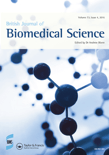
BRITISH JOURNAL OF BIOMEDICAL SCIENCE
Exploring Innovations in Biomedicine and BeyondBRITISH JOURNAL OF BIOMEDICAL SCIENCE is a distinguished peer-reviewed journal dedicated to publishing high-quality research in the field of biomedical science. Published by FRONTIERS MEDIA SA, this journal aims to advance knowledge in essential disciplines such as biochemistry, immunology, microbiology, and infectious diseases. Since its inception in 1993, the journal has maintained a solid reputation, achieving notable rankings across multiple Scopus categories, including Q2 in Biochemistry (medical) and Q3 in Clinical Biochemistry and Infectious Diseases. With an emphasis on open access, it facilitates the widespread dissemination of scientific knowledge, ensuring that researchers, professionals, and students can access cutting-edge studies and findings essential for driving innovation in medical and clinical practices. The journal's rigorous editorial standards and commitment to scientific excellence make it an invaluable resource for anyone looking to stay at the forefront of research in biomedical sciences.

Journal of Oral Health and Oral Epidemiology
Bridging Research and Practice in Oral HealthJournal of Oral Health and Oral Epidemiology, published by Kerman University of Medical Sciences, is a premier Open Access journal dedicated to advancing the scientific understanding of oral health, epidemiology, and related fields. Since its inception in 2012, the journal has been committed to providing a platform for high-quality research that addresses critical issues in oral health care, promoting interdisciplinary collaboration among researchers, clinicians, and policymakers. With its focus on publishing original articles, reviews, and case studies, the journal aims to bridge the gap between research and practice in dentistry and public health. As an important resource for practitioners and academics alike, it plays a crucial role in disseminating knowledge and fostering advancements in oral health practices worldwide. For those in pursuit of groundbreaking research and insights in the domain of oral health, the Journal of Oral Health and Oral Epidemiology is an essential publication that contributes significantly to the global dialogue in this vital field.
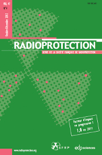
RADIOPROTECTION
Advancing safety in the realm of radiation.RADIOPROTECTION, published by EDP SCIENCES S A, stands as a pivotal journal in the multidisciplinary fields of Nuclear Energy, Public Health, and Environmental Safety. With an ISSN of 0033-8451 and an E-ISSN of 1769-700X, this journal delves into the crucial aspects of radiation protection and its interactions with health and environment, providing a platform for researchers and professionals to disseminate their findings and insights. Despite being classified in the Q4 quartile for Health, Toxicology and Mutagenesis in 2023, its Q3 status in prestigious categories such as Nuclear Energy and Engineering, and Public Health, underscores its relevance in contemporary academic discourse. The journal continues to expand its cachet with converged years of publication from 1977 to 1981 and 1988 to 2024, ensuring a rich history of scholarly contributions. Access options for interested readers include traditional subscriptions, allowing for comprehensive engagement with a broad range of topics surrounding safety, sustainability, and risk management. Whether you are a researcher, professional, or student, RADIOPROTECTION serves as an essential resource for expanding understanding and fostering innovation within its field.
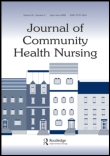
Journal of Community Health Nursing
Fostering Collaboration in Community Health Nursing ExcellenceJournal of Community Health Nursing, published by Routledge Journals, Taylor & Francis Ltd, serves as a leading platform in the field of community health nursing, exploring vital issues related to public health, community care, and environmental health. With an ISSN of 0737-0016 and an E-ISSN of 1532-7655, this journal has been a cornerstone for researchers and practitioners since its inception in 1984, converging its expertise through to 2024. The journal is currently positioned within the Q3 quartile in both community and home care as well as public health categories, reflecting its commitment to high-quality, impactful research. Although it does not offer open access, the journal remains a significant resource, providing insight and findings that underpin effective community health practices. Researchers, professionals, and students are encouraged to engage with the wealth of knowledge shared within its pages, contributing to the ongoing efforts aimed at enhancing population health outcomes.
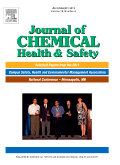
ACS Chemical Health & Safety
Empowering safer practices for a healthier future.ACS Chemical Health & Safety, published by the American Chemical Society, serves as a vital resource in the field of chemical health and safety. With the ISSN 1871-5532 and E-ISSN 1878-0504, this journal focuses on advancing knowledge regarding safety practices in chemical research and industry, promoting the development of safer practices and technologies. It holds a respectable position with a 2023 categorization of Q3 in Chemical Health and Safety, Q2 in miscellaneous Chemistry, and Q3 in Public Health, Environmental and Occupational Health. Positioned in the United States, ACS Chemical Health & Safety is accessible through various platforms, ensuring that the latest research reaches a wide audience. As the journal converges years from 2006 to 2024, it continuously aims to disseminate high-quality research articles that enhance the understanding of hazards and risk mitigation strategies. By providing critical insights and fostering a culture of safety, this journal plays a crucial role in the ongoing discourse among researchers, professionals, and students in the domain of chemical sciences.